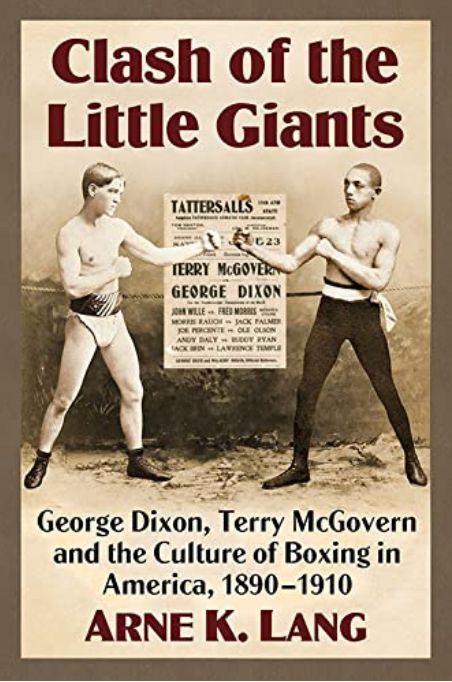With his latest book, Clash of the Little Giants – George Dixon, Terry McGovern and the Culture of Boxing in America, 1896-1910, Arne K. Lang uses the battle between two turn-of-the-20th Century titans to tell the story of the first boxers in the lighter weight divisions to capture the imagination of the American public. The first eight chapters trace George Dixon’s career from his debut in 1886 through his reigns as world bantam (1890-91) and featherweight champions (1892-97, 1898-1900). Chapters 9 to 13 focus primarily on “Terrible” Terry McGovern’s meteoric rise to stardom, his kayo of Dixon on January 9, 1900 to annex the featherweight title, and his upset loss to Young Corbett II the next year. Chapters 14 to 18 record the tragic downhill slides and deaths of both men at the identical ages of 37.
Lang’s pairing of Dixon’s story with McGovern’s opens the door to a treasure trove of topics. Dixon’s vagabond career presents a sharp contrast with Terry’s more linear path to fame as hero of Brooklyn’s Irish community. Dixon’s accomplishments are particularly remarkable when the era’s unsettled state of world championships is taken into account. To make his case, Dixon was forced to forge his destiny bit by bit while traveling to places which were sometimes closed-minded to boxing as a sport, let alone to a Black man as champion. Known in the sporting world as “Little Chocolate,” he had to track down and defeat champions of three continents to earn recognition not only as boxing’s first Black champion, but also as the first undisputed world champion in the bantam and featherweight divisions.
Dixon’s prior success in clearing the field and establishing New York as a center of boxing for the lighter divisions made Terry McGovern’s path to a world title after he turned pro in 1897 much easier than it otherwise would have been. Growing up in Brooklyn with its huge population of Irish boxing fans and its proximity to the world’s most important newspapers, McGovern was able to build his reputation as a kayo artist without leaving home. Terry’s cause was also aided by the passage of the 1896 Horton Law which permitted “athletic clubs” to legally stage fights up to 25 rounds, thus making New York an ideal setting for major contests. Among the clubs thriving then were the Broadway A. C., which staged many of Dixon’s major fights, and the Greenwood A. C. where McGovern got his start.
The importance of the “Muscular Christianity movement” and the popularity of athletic clubs is a recurring theme in the book. Lang proposes that these developments operated in tandem to make what he terms the “culture of bruising” palatable to the general public. In addition to the New York clubs, he uses the travels of Dixon and McGovern to discuss similar clubs in other cities. We learn that Harry Gilmore’s boxing academy in Chicago, Tim Kennedy and Jim Coffroth’s 20th Century A. C. in San Francisco, the Olympic Boxing Club in New Orleans, and the Athenian and Pelican clubs in Boston were the vehicles by which boxing was allowed by the authorities. Often, the topic is discussed in the context of the political maneuvering which led to these sometimes quasi-legal arrangements.
Along the way, Lang sprinkles his text with tidbits about other key figures. He describes Dixon’s adopted home of Boston in the 1890s as a hub for the era’s best Black boxers and includes biographical sketches of such rarely profiled pioneers as Ed Binney, George Byers, Billy Hill, Professor Andy Watson, and the original George Godfrey. Dixon’s famous stablemate Barbados Joe Walcott and their manager Tom O’Rourke also come in for special treatment, as do many of Dixon’s opponents. Figuring prominently in the era’s politics are Brooklyn’s Hugh “Boss” McLaughlin and the Bowery’s “Big” Tim Sullivan, who both supported boxing. Of particular interest is the fact that McGovern’s co-manager was 26-year-old Sam Harris who later partnered with George M. Cohan in producing Broadway musicals.
There is no fluff in this book. Its 155 pages of text are engagingly written and packed with absorbing information. It is well researched, smartly laid out, and thoroughly documented with an index, a bibliography, chapter endnotes, and appendices. The book includes 24 pictures which are crystal clear and embedded in the text for easy reference. They have the look of having been struck from original prints or studio negatives and add greatly to the overall enjoyment of the narrative.
The author’s background as an accredited sociologist and experienced boxing historian makes him uniquely situated to explore the cultural aspects of boxing and offer fresh insights into the sport’s development. The book is a valuable addition to our knowledge of a neglected area of study and should be of considerable interest to those interested in boxing history.
Respectfully submitted by John Ochs
This book is available at McFarland Publishing and Amazon.Com
John Ochs is the author of ‘The One is Jack Hurley’, the acclaimed 3 volume bio-history of the Golden Age of US boxing, from Jack Dempsey in the 1910’s to George Foreman in 1970, as filtered through the life of the renowned boxing manager and promoter Jack Hurley.
